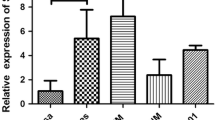Abstract
Background
Increased expression of S100A6 in many cancer tissues and its association with tumor behavior and patient prognosis were demonstrated, and there are no studies analyzing the serum levels of S100A6 in patients with gastric cancer (GC).
Aim
Serum S100A6 levels were investigated as a marker of tumor aggressiveness in patients with GC, and the S100A6 gene was examined as a potential therapeutic target in GC.
Methods
Serum S100A6 levels were detected in 103 GC patients and 72 healthy subjects by ELISA. Clinicopathological features of GC patients were analyzed in correlation to serum S100A6 levels. Two small interfering RNAs against S100A6 (siRNA1-S100A6 and siRNA2-S100A6) were generated and transfected into SGC7901 cells using pSUPER gfp-neo vector, and the effects of S100A6 knockdown on cell proliferation, invasion and apoptosis were evaluated in vitro. The effects of S100A6 silencing on tumor growth and metastasis were evaluated in vivo in a pseudo-metastatic GC nude mouse model.
Results
Serum S100A6 levels were significantly higher in GC patients than in healthy controls (P < 0.001). Serum S100A6 levels were significantly correlated with lymph node metastasis, TNM stage, perineural invasion and vascular invasion. Serum S100A6 level was an independent predictor of overall survival. SiRNA-mediated silencing of S100A6 significantly induced apoptosis and decreased proliferation, clone formation and the invasiveness of GC SGC7901 cells in vitro and significantly reduced tumor volume and number in vivo (P < 0.01).
Conclusion
Serum S100A6 level may serve as a potential prognostic biomarker in GC. Inhibition of S100A6 decreased the metastatic potential of GC cells.






Similar content being viewed by others
References
Pisani P, Parkin DM, Bray F, Ferlay J. Estimates of the worldwide mortality from 25 cancers in 1990. Int J Cancer. 1999;83:18–29.
Murray CJ, Lopez AD. Alternative projections of mortality and disability by cause 1990–2020: Global Burden of Disease Study. Lancet. 1997;349:1498–1504.
Meyerhardt JA, Fuchs CS. Chemotherapy options for gastric cancer. Semin Radiat Oncol. 2002;12:176–186.
Kwon HC, Kim SH, Oh SY, et al. Clinicopathologic significance of expression of nuclear factor-κB RelA and its target gene products in gastric cancer patients. World J Gastroenterol. 2012;18:4744–4750.
Cross SS, Hamdy FC, Deloulme JC, Rehman I. Expression of S100 proteins in normal human tissues and common cancers using tissue microarrays: S100A6, S100A8, S100A9 and S100A11 are all overexpressed in common cancers. Histopathology. 2005;46:256–269.
Lesniak W, Slomnicki LP, Filipek A. S100A6-new facts and features. Biochem Biophys Res Commun. 2009;390:1087–1092.
Tonini GP, Fabretti G, Kuznicki J, et al. Gene expression and protein localisation of calcyclin, a calcium-binding protein of the S-100 family in fresh neuroblastomas. Eur J Cancer. 1995;31A:499–504.
Sofiadis A, Dinets A, Orre LM, et al. Proteomic study of thyroid tumors reveals frequent up-regulation of the Ca2+-binding protein S100A6 in papillary thyroid carcinoma. Thyroid. 2010;20:1067–1076.
Luu HH, Zhou L, Haydon RC, et al. Increased expression of S100A6 is associated with decreased metastasis and inhibition of cell migration and anchorage independent growth in human osteosarcoma. Cancer Lett. 2005;229:135–148.
Kim J, Kim J, Yoon S, et al. Choe I.S100A6 protein as a marker for differential diagnosis of cholangiocarcinoma from hepatocellular carcinoma. Hepatol Res. 2002;23:274.
Vimalachandran D, Greenhalf W, Thompson C, et al. High nuclear S100A6 (Calcyclin) is significantly associated with poor survival in pancreatic cancer patients. Cancer Res. 2005;65:3218–3225.
Ohuchida K, Mizumoto K, Ishikawa N, et al. The role of S100A6 in pancreatic cancer development and its clinical implication as a diagnostic marker and therapeutic target. Clin Cancer Res. 2005;11:7785–7793.
Yang YQ, Zhang LJ, Dong H, et al. Upregulated expression of S100A6 in human gastric cancer. J Dig Dis. 2007;8:186–193.
Wang XH, Zhang LH, Zhong XY, et al. S100A6 overexpression is associated with poor prognosis and is epigenetically up-regulated in gastric cancer. Am J Pathol. 2010;177:586–597.
Chen D, Jiao XL, Liu ZK, Zhang MS, Niu M. Knockdown of PLA2G2A sensitizes gastric cancer cells to 5-FU in vitro. Eur Rev Med Pharmacol Sci. 2013;17:1703–1708.
Ohuchida K, Mizumoto K, Ishikawa N, et al. The role of S100A6 in pancreatic cancer development and its clinical implication as a diagnostic marker and therapeutic target. Clin Cancer Res. 2005;11:7785–7793.
Luo X, Sharff KA, Chen J, He TC, Luu HH. S100A6 expression and function in human osteosarcoma. Clin Orthop Relat Res. 2008;466:2060–2070.
Tsoporis JN, Izhar S, Parker TG. Expression of S100A6 in cardiac myocytes limits apoptosis induced by tumor necrosis factor-alpha. J Biol Chem. 2008;283:30174–30183.
Acknowledgments
Authors received grant support from National Natural Science Foundation of China (No. 81370567).
Conflict of interest
None.
Author information
Authors and Affiliations
Corresponding author
Rights and permissions
About this article
Cite this article
Zhang, J., Zhang, K., Jiang, X. et al. S100A6 as a Potential Serum Prognostic Biomarker and Therapeutic Target in Gastric Cancer. Dig Dis Sci 59, 2136–2144 (2014). https://doi.org/10.1007/s10620-014-3137-z
Received:
Accepted:
Published:
Issue Date:
DOI: https://doi.org/10.1007/s10620-014-3137-z




